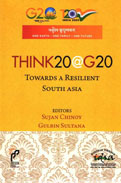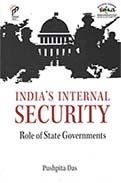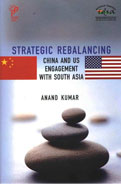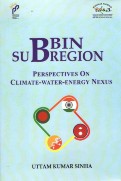You are here
-

- Publisher: Pentagon Press
2024
India’s G20 Presidency, based on the principle of inclusivity, gave special importance to the priorities of the Global South. The Think20 engagement group (T20), the ‘Ideas Bank’ for the G20, played a crucial role in connecting scholars and experts to harness ideas to enrich the G20 agenda and benefit the larger global community. One of the endeavours in this regard was to gather the perspectives of South Asian countries during India’s G20 Presidency, using the collection of speeches and select papers presented during the 14th South Asia Conference organised by the Manohar Parrikar Institute for Defence Studies and Analyses on 17-18 January 2023. This volume provides various national perspectives on some of the crucial non-traditional issues confronting South Asian countries, including Myanmar, and well-researched ideas to deal with those challenges effectively. It contextualises the role of India as G20 President, and beyond, in addressing some of the pressing regional issues.- ISBN: 9788197198601 ,
- Price: ₹ 1295/-
- Publisher: Pentagon Press
-

- Publisher: Pentagon Press
2024
While it is a common knowledge that the Union government has been primarily responsible for maintaining the security of the country, the state governments have also played an important role ensuring public order and security of the citizens. It is said that every conflict starts at the micro level, but if not addressed effectively at that level, it has the potential to blow up and manifest itself as a severe security threat for the entire country. In this respect, various affected state governments in India have attempted to resolve conflicts and build peace at the ground level. While some of these attempts have been successful others have not accomplished the desired results. The book analyses the experiences of six selected states in their efforts to deal with insurgencies and establish sustainable peace. By doing so, it brings to the fore the important role played by state governments in tackling various internal security threats and maintaining peace and order in the country. The book argues in favour of the necessity to consider state governments as a prominent component in India’s conflict resolution and peace building architecture.- ISBN: 9788196872205 ,
- Price: ₹ 1295/-
- Publisher: Pentagon Press
-

- Publisher: Pentagon Press
2024
The relationship between China, the US, and South Asia holds significant implications for global politics and security dynamics due to several reasons. South Asia is strategically located at the crossroads of major global trade routes, making it crucial for regional stability and economic prosperity. Its geopolitical significance is further amplified by its proximity to the Indian Ocean, a vital maritime corridor for global commerce. As such, any developments in South Asia have far-reaching consequences for international trade and security.China’s rapid economic ascent and expanding influence in South Asia has altered the traditional power dynamics in the region. With its ambitious Belt and Road Initiative (BRI), China has invested heavily in infrastructure projects across South Asia, enhancing connectivity and economic ties. This has enabled China to assert itself as a major player in the region, challenging the influence traditionally held by the US and other Western powers.
This book delves into the intricate relationship between China`s rise and US engagement with South Asia, addressing several key questions. First, it explores how China`s rise as a major power has influenced US involvement in South Asia. Additionally, it investigates the significance of South Asia in the broader strategic calculations of the US. Finally, it examines how evolving geopolitical dynamics shape American strategies in the region.
This book provides a comprehensive analysis of the intricate relationship between the US, China, and South Asia, offering insights into the geopolitical shifts and strategic considerations that have shaped the region`s dynamics.
- ISBN: 9788197198618 ,
- Price: ₹ 1295/-
- Publisher: Pentagon Press
-

- Publisher: Pentagon Press
2024
This volume delves into the multifaceted relationship between India and African countries, focusing on their evolving security, economic, energy and technological cooperation. It tracks the development of this partnership, highlighting India`s proactive involvement in Africa. The volume examines India`s contributions to African security, including maritime security, as well as its role in addressing energy and food security challenges on the continent. It also delves into the complexities of cybersecurity and skill development, underscoring the importance of collaborative efforts to tackle mutual concerns. Through a detailed analysis, this volume provides valuable insights and recommendations for enhancing the strategic partnership between India and Africa in the years ahead.- ISBN: 9788197198687 ,
- Price: ₹ 1295/-
- Publisher: Pentagon Press
-

- Publisher: Pentagon Press
2024
The idea for this book emerged in the course of discussions during the initial stages of the Ukraine War. It was, however, realised that any attempt at drawing lessons prematurely could lead to misleading conclusions. Accordingly, instead of absolutist conjectures, the book is an exercise in identifying broader trends.Much water has flown under the bridge since then. Along the way, the world has been introduced to an array of new sophisticated weapons, missiles and drones that question the very relevance of established battlefield platforms such as tanks, for instance. In this volume, the contributors address several aspects of the war in an attempt to explain, elaborate and challenge existing notions with the larger aim of drawing lessons for policymakers and professionals alike.
Ukraine War: Military Perspectives and Strategic Reflections, presents a comprehensive assessment of the ongoing conflict. Divided into five sections, the book delves into the geopolitical backdrop of the conflict, highlights its operational narrative, dissects the components of military power, explores the impact of disruptive technologies and examines the strategic ramifications of this ongoing war.
- ISBN: 978-81-968722-8-1 ,
- Price: ₹ 1495/-
- Publisher: Pentagon Press
-

- Publisher: Pentagon Press
2024
This book represents an effort to present views on peace, security and development partnership between India and the African countries. India and Africa both recognise that peace, security and development are intimately interwoven. While peace ensures opportunity for development, security enables as well as protects fruits of development. Africa is a continent which has witnessed many conflicts. However, Africa has also witnessed economic growth and political reform in the past decade. This volume brings together perspectives from Indian and African experts on diverse issues such as security, trade, development, conflict resolution, peacekeeping, terrorism and climate change. It will be of interest to students and researchers of African studies, India- Africa relations and security studies.- ISBN: 9788196872298 ,
- Price: ₹ 1295/-
- Publisher: Pentagon Press
-

- Publisher: Pentagon Press
2024
West Asia holds significant relevance for India due to a multitude of economic, political, strategic and security factors. India considers the West Asian region as its ‘extended neighbourhood.’ Since Prime Minister Narendra Modi assumed office in 2014, India’s West Asia policy has received renewed attention, marking a notable transformation in its foreign policy approach towards the countries of the region. In recent years, engagement between India and the West Asian region has moved beyond the traditionally dominant spheres of trade, energy and diaspora ties. India has emphasised cooperation in the fields of defence and security, building strategic partnerships and is exploring new areas of cooperation in sectors such as renewable energy, health, climate change, food security, connectivity and so on. Prime Minister Modi’s ‘Think West’ policy has further prioritised engagement with the West Asian countries.This book provides scholarly perspectives on Modi’s policy and approach towards the West Asian region. The authors reflect on different dimensions of the India–West Asia relationship, examine the key changes in India’s approach under the Modi government and explore the opportunities and prospects of cooperation in the new and emerging fields. The authors aver that Prime Minister Modi’s continuous engagement with the regional leaders at bilateral and multilateral levels, the convergence of interests between India and the West Asian countries, India’s increasing stakes in the region and a changing perception of India in the minds of regional leaders are some of the key drivers of the fast-growing India–West Asia relationship.
- ISBN: 978-81-968722-2-9 ,
- Price: ₹ 1295/-
- Publisher: Pentagon Press
-

- Publisher: Pentagon Press
2024
This volume provides perspectives of scholars from India and West Asia on several bilateral issues of concern, challenges and scope for further cooperation. The authors contend that a convergence of interests between India and West Asian countries across numerous domains, coupled with India`s escalating stakes in the region, and the growing recognition among West Asian nations of India`s burgeoning economic and political influence, stand as key drivers underpinning the India-West Asia relationship. Furthermore, they have underscored that under the leadership of Prime Minister Narendra Modi, India’s West Asia policy has undergone a major transformation.- ISBN: 9789390095971 ,
- Price: ₹ 995/-
- Publisher: Pentagon Press
-

- Publisher: Pentagon Press
2023
This book deals with the history of Muslim political thought from the time of the Prophet to early 21" century in `West Asia` (an Indian alternative to the `colonial` term Middle East) and South Asia. Although Islam does not present nor recommend any political philosophy or state-like system per se, Muslim scholars and theologians have over the centuries recommended ways for establishing an ideal Islamic polity based on Quranic inferences, precedents of the Prophet and some early Caliphs. Although Political Islam strictly refers to only a century-old religious-political revivalist movement, this book covers historical concepts and developments that serve as political antecedents for contemporary Political Islam in the two regions.- ISBN: 9788195189458 ,
- Price: ₹ 1995/-
- Publisher: Pentagon Press
-

- Publisher: Pentagon Press
2023
Bangladesh, Bhutan, India and Nepal (BBIN) are home to 21 per cent of the world’s population. With projected economic growth in the BBIN countries, a consequent increase in the demand for electricity and heavy dependence on fossil fuels are expected despite the pitch for renewable energy. The region also faces unprecedented climate change, particularly in the Hindu Kush Himalaya, the cradle of major sub-continental rivers, and where melting glaciers, unpredictable weather conditions, and rainfall patterns are affecting the life of millions and instigating frequent natural disasters. Since 2014, India has tried to maximise sub-regional interaction with the aim of promoting cooperation in the economic, social, cultural and scientific fields. This has opened new thinking and opportunities, complementing the pace of globalisation and liberalisation. The fear, of course, is that this approach can easily dissipate in the face of security complexities and political difficulties.The climate-water-energy nexus is now a familiar concept in the resource management debate requiring long-sighted approaches that help avoid maladaptive pathways and, as a tool, to anticipate the tilt and balance of the nexus resources and the nature of their interactions. The nexus as a policy approach brings together the concept of ‘security and sustainability’. However, the framing of the nexus around a scarcity crisis narrative often pushes states towards control and possessiveness of the resources rather than driving them towards stability and durability solutions. Beyond this framework, a more nuanced political–economy understanding of the BBIN sub-region is essential.
- ISBN: 9788195189458 ,
- Price: ₹ 995/-
- Publisher: Pentagon Press
